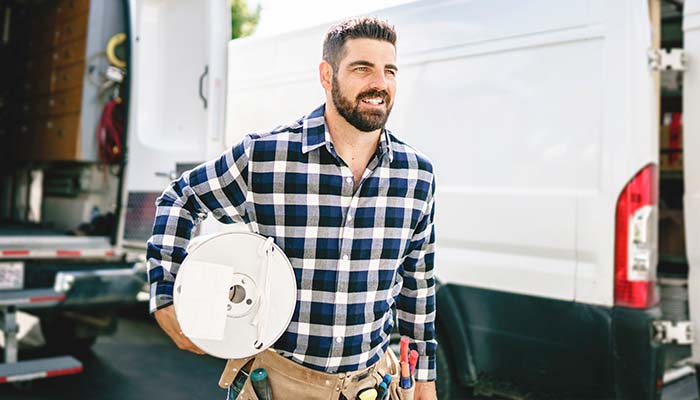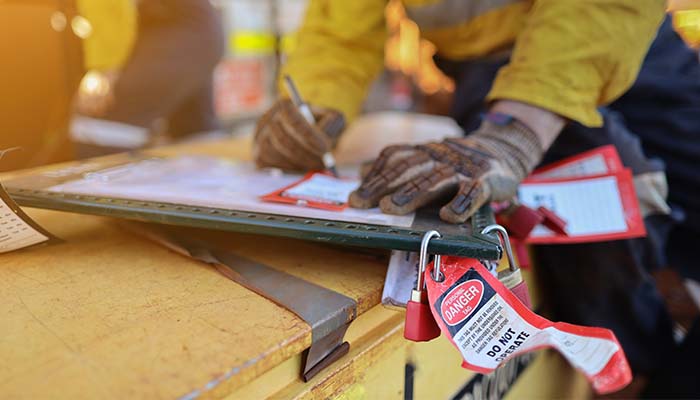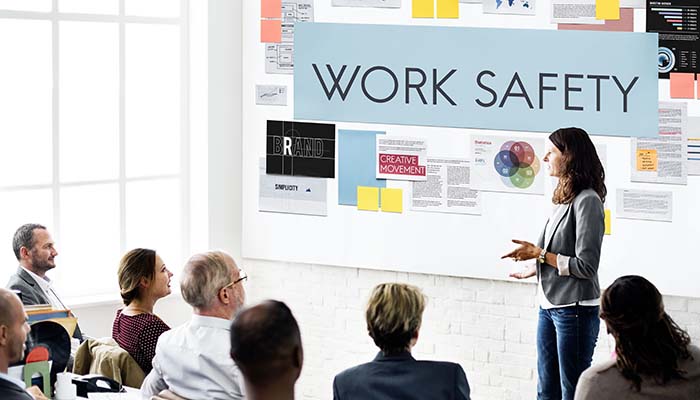Congratulations on taking the entrepreneurial leap to start your own business! Going from an employee to an employer is an exciting but challenging transition. Whether you're brewing the perfect latte in a cozy café or overseeing a bustling construction site, your new role comes with many responsibilities you may not have encountered before. One crucial area you can't afford to overlook is health and safety.
Navigating the labyrinth of WHS laws in Australia might seem daunting, but don't worry - this guide is designed to walk you through the essentials. We'll use relatable examples from two different industries to help you understand the key aspects of health and safety compliance.
Meet Sarah: From Barista to Café Owner in New South Wales
Sarah spent a decade in the hospitality industry, mastering everything from brewing the perfect cup of coffee to customer service. Recently, she decided to channel her skills into opening her own café. While Sarah is no stranger to the hustle and bustle of café life, taking on the role of a business owner brought new responsibilities, particularly in the realm of health and safety.

Understanding the Basics
Sarah starts her journey by delving into the Work Health and Safety Act (WHS Act), which is the foundation for Australia's health and safety regulations. The WHS laws may appear complicated, but they essentially boil down to four main duties:
- A Safe Environment: Ensure the workspace is free from hazards.
- Proper Facilities: Maintain clean and functional restrooms, kitchens, and break rooms.
- Training and Information: Educate the team on safety procedures.
- Regular Checks: Monitor workplace conditions to ensure ongoing safety.
Local Flavour: State-Specific Regulations
Since her café is located in New South Wales, Sarah also needs to understand and comply with the state-specific WHS laws. For instance, there are additional guidelines on food safety that she needs to adhere to, reinforcing the idea that local laws can supplement state and federal requirements.
Special Considerations for the Hospitality Industry
For Sarah, food safety, cleanliness, and waste disposal guidelines are particularly important. Given that she's in the hospitality industry, these areas require extra attention to ensure employees' and customers' health and safety.
Essential Health and Safety Documents for Sarah's Café
Sarah's business, like any other, needs to keep important health and safety documents to ensure a safe working environment and to comply with regulatory requirements. Here are some crucial documents that could be of great help:
- WHS Policy Statement: This foundational document clarifies the café's commitment to safety and sets the tone for all other safety measures.
- Risk Assessment Forms: These help Sarah identify and assess potential hazards in her café - everything from scalding coffee pots to trip hazards, helping her decide how best to mitigate these risks.
- Safe Operating Procedures (SOP): SOPs are guidelines outlining the safest way to complete tasks that may be hazardous if not performed correctly, such as operating kitchen appliances.
- Incident Report Forms: Vital for documenting any workplace incidents or near-misses, these forms are crucial for learning from past mistakes and preventing future ones.
- Employee Training Manuals: These documents offer essential information on health and safety protocols, helping new and existing employees stay current.
- Emergency Response Plan: Because emergencies are unpredictable, having a plan in place for fires, medical emergencies, or other unforeseen events is key.
- Maintenance Logs: Regularly updated logs ensure that all equipment - from espresso machines to fire extinguishers - is in working order and safe to use.
- Food Safety Plan: Specific to the hospitality industry, this plan outlines proper food storage, preparation, and serving guidelines to prevent food-borne illnesses.
- First Aid Checklist: Ensuring a well-stocked and up-to-date kit can be a lifesaver in some situations.
- Compliance Checklists: Daily or weekly checklists help Sarah ensure that no crucial safety steps are overlooked, providing her with peace of mind.
Investing time and resources in these documents will not only help Sarah run a safe and compliant café but will also serve as documented proof of her diligent commitment to safety. Businesses like SafetyDocs by SafetyCulture offer a wide range of these documents tailored to different industries, making compliance that much simpler for business owners.
Meet Alex: An Electrician in Queensland
After years as an electrician, Alex decided it was time to start his own electrical contracting business. Based in Queensland, he's well-versed in the electrical work itself but now faces new challenges that come with business ownership - especially compliance with health and safety regulations.

Understanding Regulatory Requirements in Queensland
Alex also has a series of legal obligations to fulfil:
- Work Health and Safety Act 2011 (QLD): This is the primary piece of legislation governing workplace safety in Queensland. It outlines the general OHS obligations for employers and workers.
- Electrical Safety Act 2002: Specific to electrical safety, this Act covers safety standards, licensing, and enforcement in Queensland.
- Work Health and Safety Regulation 2011: This regulation contains the detailed provisions, such as the type of personal protective equipment (PPE) that must be worn.
- Electrical Safety Regulation 2013: These set out specific safety requirements for electrical work, including the use of safety switches, testing, tagging of equipment, and more.
- Codes of Practice: These practical guidelines cover various types of electrical work and are used as standards to determine what is 'reasonably practicable' in ensuring electrical safety.
- Australian Standards: National standards that apply to electrical installations (AS/NZS 3000, also known as the Wiring Rules) and other areas of electrical work.
- Licensing: Alex must hold a valid electrical work license issued by the Electrical Safety Office. Different types of licenses exist, depending on the scope and complexity of the electrical work.
- Training and Competence: Proper training and qualifications are mandatory, often including first aid and periodic refresher training in safety procedures.
- Risk Assessments: Before beginning any work, these need to be conducted to identify potential hazards and determine control measures.
- Safe Work Method Statements: A Safe Work Method Statement (SWMS) must be prepared and followed for certain types of work.
- Incident Reporting: Any electrical safety incidents must be reported to the Electrical Safety Office.
Navigating Legal Waters: The Twin Challenges of Civil and Regulatory Accountability for Small Businesses
Despite their businesses operating in distinct sectors, both Sarah and Alex must navigate a web of legal responsibilities that present potential pitfalls if not adequately addressed.
Civil Liability: More Than Just Paperwork
While it might be tempting to view compliance documents as mere formalities, Alex and Sarah face serious civil repercussions for any lapses in health and safety protocols. For Sarah, omitting a simple 'Wet Floor' sign could escalate into a legal nightmare if a customer slips and falls. For Alex, a mistake as minor as faulty wiring could snowball into a lawsuit if it causes an electrical fire in a client's home.
Regulatory Obligations: The Queensland Context
Being in Queensland adds another layer of complexity for Alex, who is required to comply with multiple laws, such as the Work Health and Safety Act 2011 and the Electrical Safety Act 2002, along with their associated regulations and codes of practice. Non-adherence can result in severe penalties, including loss of licensure. Sarah isn't exempt either; she needs to meet stringent food safety protocols and general occupational health standards. Non-compliance could mean hefty fines or even temporary shuttering of her café.

Beyond the Legal Costs: The Ripple Effect of Non-Compliance
Financial Implications
Court proceedings can take a toll on the finances of any business. One significant lawsuit can have a cascading effect, transforming a once-thriving café or electrical service into a shell of its former self.
The Double-Edged Sword of Digital Reputations
In the age of social media, reputation is currency. A single safety violation can trigger a barrage of negative reviews and social media posts, eroding both Sarah's and Alex's hard-earned customer trust and goodwill.
Operational Hurdles: The Domino Effect
For Sarah, a severe safety violation could necessitate the temporary closure of her café. Alex could face suspension or revocation of his professional license. In both cases, the outcome spells operational havoc, severed customer relations, and a blow to their income streams.
By understanding these risks, Sarah and Alex can better appreciate the essential role of safety documents as their first line of defence, setting them on a path toward a safer, more resilient business operation.
Tips for Small Business Owners to Ensure Health and Safety
1. Regular Updates: Stay Ahead of Changes
One of the most important aspects of running a business is staying informed. Laws, guidelines, and industry standards can change frequently. Subscribe to newsletters, join industry-specific online forums, or even set up Google alerts for terms relevant to your sector's health and safety regulations. Not only does this protect you from potential legal issues, but it also shows your employees and clients that you are committed to safety.
2. Involve Employees: Teamwork Makes the Dream Work
Employee involvement is crucial for a successful health and safety program. After all, they are on the front lines, dealing with the risks and hazards first-hand. Consider setting up a safety committee or regularly hold "toolbox talks" to discuss safety issues. Employees often have insights into the practical aspects of the job that you may not have considered. Their feedback can be invaluable for enhancing safety protocols.
3. Be Proactive: Prevention is Better Than Cure
Adopting a proactive approach is always better than reacting after an incident has occurred. Conduct frequent inspections, safety drills, and audits. Use these as learning opportunities to refine your procedures. The costs involved in these activities are an investment in your business's long-term safety and success.
4. Consult Professionals: Expertise Matters
Especially in industries with highly specialised safety requirements like electrical work or food service, the advice of experts can be invaluable. Consult with health and safety professionals for an audit or a training session. They can pinpoint gaps in your current safety measures and offer solutions you might not have considered. This consultation is not an expense but an investment in ensuring your business operates without the hindrance of safety concerns.
5. Documentation: Your Legal Shield
Accurate record-keeping is not just for financial auditing but also for your safety audits. Document everything from safety inspections and equipment maintenance records to employee training sessions and incident reports. In a legal dispute, this documentation serves as proof of due diligence in maintaining a safe working environment.
6. Educate and Train: Knowledge is Power
Training is not a one-time event but an ongoing process. As regulations change or new equipment is introduced, employees should be updated and retrained as necessary. This ensures everyone is on the same page and reduces the chances of accidents due to ignorance or misunderstanding.
7. Use Technology: Digital Tools for Safety
In today's digital age, various software and mobile applications can also help you manage your health and safety requirements more efficiently. From digital checklists for daily safety inspections to incident reporting apps that streamline the process, leveraging technology can make safety management more effective. One such platform worth exploring is SafetyCulture. This resource offers a range of solutions, including a versatile app for real-time data collection, which can drastically simplify safety audits and reporting.
By implementing these tips, you'll be building a culture of safety that benefits everyone involved in your business - from the employees who come in every day to the customers who trust your products or services. Safety is not just about avoiding fines or legal issues; it's about creating a sustainable, reputable, and prosperous business.

The Role of SafetyDocs by SafetyCulture in Your Health and Safety Compliance Strategy
When it comes to health and safety, the saying "the devil is in the details" couldn't be truer. The strength of your health and safety program lies in your documentation. While you may have general knowledge of safety protocols, translating that into action requires concrete plans, risk assessments, and checklists, among other documents.
Where do you find these documents? How do you ensure they comply with current laws and regulations? Enter SafetyDocs by SafetyCulture - an e-commerce store specifically designed to provide a wide array of HSEQ documents tailored to meet the needs of businesses across various industries.
Why Choose SafetyDocs by SafetyCulture?
- Quality Assured: All documents are designed by experts in the field of health and safety and are compliant with Australian regulations.
- Industry-Specific: From hospitality to construction, SafetyDocs offers documents designed to meet the unique needs of your industry.
- Up-to-Date: With WHS laws and regulations ever-changing, SafetyDocs ensures all documents are kept up-to-date with the latest requirements.
- Easily Accessible: No need for an appointment or waiting period. Get instant access to the documents you need right when you need them.
- Cost-Effective: Use reliable, pre-made documents to save on legal fees and consultancy costs.
Real-Life Applications: Safety Solutions for Sarah's Café and Alex's Electrical Business
Sarah, who owns a bustling café, and Alex, our electrical contractor, are keen to enhance workplace safety and compliance. SafetyDocs by SafetyCulture provides a wealth of resources tailored to their industries that could be game-changers for them.
For Sarah, and other café owners, the following documents are a great place to start:
- Total Management System for Cafés and Restaurants: With over 70 supporting documents available, this comprehensive management system could be a one-stop solution for all her safety needs.
- Workplace Hygiene Plan: Sarah might find this hygiene plan beneficial for maintaining cleanliness across her café.
- Kitchen Service SWMS: This safe work method statement could provide a framework for safe kitchen operations.
- Deep Fryer SOP: This standard operating procedure for deep fryers could help ensure safe cooking practices in her café.
For Alex:
- Total Management System for Electricians: This integrated system offers a comprehensive selection of documents designed to ensure workplace safety, environmental sustainability, and quality control.
- Electrical Emergency Response Plan: Alex might consider this emergency response plan to prepare for any electrical emergencies.
- Electrical New Installation SWMS: This safe work method statement could guide him through new electrical installations.
- Electricians SWMS Pack: This value pack offers a range of safe work method statements tailored for electrical work.
By leveraging these documents from SafetyDocs by SafetyCulture, Sarah and Alex could make significant strides in their respective health and safety compliance efforts. And remember, these are just two industry snapshots; SafetyDocs can assist with an array of other sectors, from construction and manufacturing to healthcare and transport.
Your Proactive Blueprint for Safety
When it comes to health and safety compliance, many businesses find themselves in reactive modes, trying to adapt their operations in response to incidents or regulatory scrutiny. Documentation often becomes a last-minute scramble in this framework, a last line of defence against legal repercussions. However, this approach misses the real opportunity for creating safer and more effective workplaces.
At SafetyDocs by SafetyCulture, we strongly advocate for a different perspective: use documentation as your first line of defence, not your last. Our website offers Australian businesses a broad array of meticulously crafted, industry-specific safety documents, from risk assessments to SOPs.
These aren't just bureaucratic necessities but proactive tools for shaping organisational behaviour, setting expectations, and guiding effective responses to real-world situations. By employing SafetyDocs as an integral part of your safety strategy, you can transition from merely reacting to actively shaping a work environment that prioritises safety, efficiency, and compliance.
With the correct documentation in place, Australian businesses not only shield themselves against legal pitfalls but also showcase their commitment to the welfare of their team and customers.
So take the first step today with SafetyDocs by SafetyCulture, and transform your documentation from a regulatory obligation into a strategic asset for safety and success.
We have also created a simple to use document finder that helps you easily search hundreds of documents to find what is best suited to your workplace, based on your industry and requirements. Try it now.
Author - Craig Cruickshank is the HSEQ Manager and Senior Technical Advisor at SafetyDocs by SafetyCulture.
Craig comes from a construction and environmental background, with experience in both the private and public sectors and is passionate about making health and safety information easy to find and understand for everyone.
Learn more about Craig's work on LinkedIn
Available for instant download and supplied in fully editable MS Word format for use in your business.
Please note that the above information is provided as a comment only and should not be relied on as professional, legal or financial advice.
Share This Article
